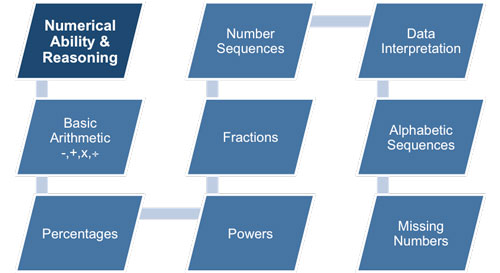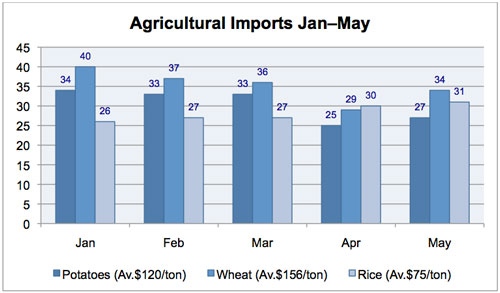Numerical Ability and Reasoning Tests
Numerical skills are a vital part of any manager's role, so it is not surprising that numerical ability and reasoning tests are an essential element of aptitude tests.
Management-level tests usually concentrate on higher-level skills like data interpretation but if you feel as though your math is a bit rusty then it is worth spending some time working through some basics to refresh your memory.
 |
These speed tests are designed to determine your skills at basic arithmetic and mathematics including number sequences and data interpretation. You will not be able to use a calculator so practice is essential to achieve the necessary speed and accuracy to attain a high score when answering 25-35 questions in 20-30 minutes. Here are some examples of arithmetic questions:
1. 139 + 235 =
A) 372 B) 374 C) 376 D) 437
2. 139 - 235 =
A) -69 B) 96 C) 98 D) -96
3. 5 x 16 =
A) 80 B) 86 C) 88 D) 78
4. 45 / 9 =
A) 4.5 B) 4 C) 5 D) 6
5. 15% of 300 =
A) 20 B) 45 C) 40 D) 35
6. ½ + ¼ + ¾ =
A) 1 ¾ B) 1 ¼ C) 1 ½ D) ¾
Number Sequences
You will be presented with a sequence of numbers and have to identify the missing one from the multiple choices. Here are some of the more simplistic examples (their answers are shown in bold):
7. Find the next number in the series
4 8 16 32 --
A) 48 B) 64 C) 40 D) 46
(the numbers double each time)
8. Find the next number in the series
4 8 12 20 --
A) 32 B) 34 C) 36 D) 38
(each number is the sum of the previous two numbers)
9. Find the missing number in the series
54 49 -- 39 34
A) 47 B) 44 C) 45 D) 46
(the numbers decrease by 5 each time)
10. Find the first number in the series
-- 19 23 29 31
A) 12 B) 15 C) 16 D) 17
(the numbers are primes - divisible only by 1 and themselves)
Other number sequences are more complex and you have to look at the interval between the numbers to identify the sequence.
11. Find the next number in the series
3 6 11 18 --
A) 30 B) 22 C) 27 D) 29
(the first interval is 3, and the interval increases by 2 each time)
12. Find the next number in the series
48 46 42 36 --
A) 32 B) 28 C) 29 D) 30
(the first interval is 2 which is subtracted from the first number; each further subtraction increases by 2 each time)
More complex number sequences will show over four numbers so that the more complicated patterns can be figured out. See the examples below (answers shown in bold).
13. Find the missing number in the series
4 3 5 9 12 17 --
A) 32 B) 30 C) 24 D) 26
(this sequence starts with the fourth digit as the three previous digits are used for its and subsequent numbers in the sequence - for example, 9 = 5 + 4, 12 = 9 + 3, etc.)
14. Find the missing numbers in the series
5 6 7 8 10 11 14 -- --
A) 19 B) 17 C) 15 D) 16
(C is first answer, A is second answer. This sequence is two simple interleaved sequences i.e. 5→7→10→14→19. Then 6→8→11→15 - the difference increases by 1 each time.)
15. Find the missing numbers in the series
1 -- 4 7 7 8 10 9 --
A) 6 B) 3 C) 11 D) 13
(A is first answer, D is 2nd answer. Once again they are interleaved sequences i.e. 6→7→8→9 - increases by 1 each time. Then 1→4→7→10→13 - increases by 3 each time.)
The most effective way to tackle these types of questions is to look for an arithmetic relationship between the numbers first and the look at intervals for a relationship. It is common when there are more than four numbers shown in a sequence that there will be two interleaved sequences. Sometimes the relationship can be in multiples, powers, divisions, or a mixture of two options.
Alphabet Sequence as Numbers
This type of sequence tests your ability to substitute a letter in the place of a number and assess your capacity to work with the unexpected. If you see any of these sequences make sure to write down the alphabet with the numbers below to help answer these questions quickly and efficiently.
 |
Remember that these sequences may interleave and that in all cases the alphabet will loop back around in a continuous loop. This is illustrated by the examples below (answers shown in bold).
16. Find the next letter in the series
B E H K --
i) L ii) M iii) N iv) O
(this sequence skips two letters each time B→E→H→K→N)
17. Find the next letter in the series
A Z B Y --
i) C ii) X iii) D iv) Y
(this is two interleaved sequences A→B→C and Z→Y)
18. Find the next letter in the series
T V X Z --
i) Y ii) B iii) A iv) W
(this looping back sequence skips a letter each time T→V→X→Z→B)
Familiarity with this sort of concept will be the key to your success; the more practice you have of working in this way the higher your score will be.
Data Interpretation
You are not expected to have in-depth knowledge of the data presented; as with the verbal comprehension questions all you need to do is use the information supplied and interpret the data to answer each question. The questions are likely to have a managerial context that would assist decision making.
In this sort of question you are often permitted to use a calculator, but make sure that you mentally estimate the answer it gives you. Don't lose marks through careless keying or hitting '+' instead of '-'. Some examples of data interpretations questions are shown below (answers in bold).
 |
19a. State the month with the lowest sales value.
A) January B) February C) March
19b. What is the unit cost of server type ZXC-63?
A) 12 B) 13 C) 14
19c. How many ZXC43 units could be expected to sell in April?
A) 56 B) 58 C) 60
(there has been an increase of 8 units per month)
19d. Which server had its unit price changed in March?
A) ZXC43 B) ZXC53 C) ZXC63
20. The following chart shows agricultural imports for January to May. Answer the following questions using the data provided. (You may use a calculator.)
 |
20a. Which month showed the largest total decrease in imports over the previous month?
A) March B) April C) May
20b. What percentage of rice was imported in April?
A) 17% B) 19% C) 21%
(30 tons out of a total of 141)
20c. What was the total cost of wheat imports in the five-month period?
A) $27,500 B) $25,000 C) $22,000
(176 tons at an average of $156/ton)
These numerical reasoning questions determine how logical and rational your approach is to interpreting data. They are designed to assess your ability to understand series of numbers, numerical transformations, relationships between numbers, and your ability to perform numerical calculation.
You may also be interested in:
Management Aptitude Tests | Verbal Ability and Reasoning Tests | Numerical Ability and Reasoning Tests | Abstract Reasoning Tests | Spatial Ability Tests | Scoring and Ranking Results.


